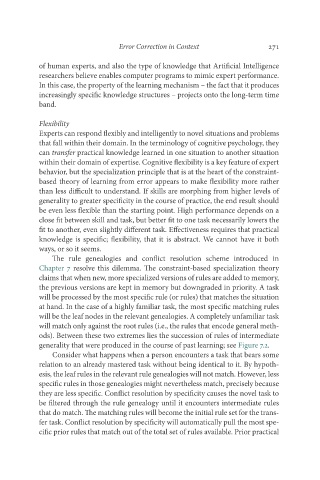Page 288 - Deep Learning
P. 288
Error Correction in Context 271
of human experts, and also the type of knowledge that Artificial Intelligence
researchers believe enables computer programs to mimic expert performance.
In this case, the property of the learning mechanism – the fact that it produces
increasingly specific knowledge structures – projects onto the long-term time
band.
Flexibility
Experts can respond flexibly and intelligently to novel situations and problems
that fall within their domain. In the terminology of cognitive psychology, they
can transfer practical knowledge learned in one situation to another situation
within their domain of expertise. Cognitive flexibility is a key feature of expert
behavior, but the specialization principle that is at the heart of the constraint-
based theory of learning from error appears to make flexibility more rather
than less difficult to understand. If skills are morphing from higher levels of
generality to greater specificity in the course of practice, the end result should
be even less flexible than the starting point. High performance depends on a
close fit between skill and task, but better fit to one task necessarily lowers the
fit to another, even slightly different task. Effectiveness requires that practical
knowledge is specific; flexibility, that it is abstract. We cannot have it both
ways, or so it seems.
The rule genealogies and conflict resolution scheme introduced in
Chapter 7 resolve this dilemma. The constraint-based specialization theory
claims that when new, more specialized versions of rules are added to memory,
the previous versions are kept in memory but downgraded in priority. A task
will be processed by the most specific rule (or rules) that matches the situation
at hand. In the case of a highly familiar task, the most specific matching rules
will be the leaf nodes in the relevant genealogies. A completely unfamiliar task
will match only against the root rules (i.e., the rules that encode general meth-
ods). Between these two extremes lies the succession of rules of intermediate
generality that were produced in the course of past learning; see Figure 7.2.
Consider what happens when a person encounters a task that bears some
relation to an already mastered task without being identical to it. By hypoth-
esis, the leaf rules in the relevant rule genealogies will not match. However, less
specific rules in those genealogies might nevertheless match, precisely because
they are less specific. Conflict resolution by specificity causes the novel task to
be filtered through the rule genealogy until it encounters intermediate rules
that do match. The matching rules will become the initial rule set for the trans-
fer task. Conflict resolution by specificity will automatically pull the most spe-
cific prior rules that match out of the total set of rules available. Prior practical

